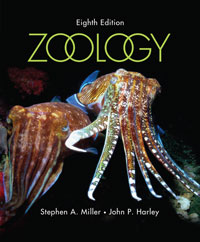1.
A) tolerance factor. B) acclimator. C) limiting factor. D) optimum factor. 2.
A) range of optimum. B) tolerance range. C) existence range. D) home range. 3.
A) existence energy--the energy it takes to survive B) resistance energy--the energy it takes to resist change in the environment C) productive energy--the energy it takes to grow and reproduce D) excretory energy--the energy lost through feces and excretion 4.
A) I B) II C) III D) IV 5.
A) 2--->4--->6--->8 B) 2--->3--->4--->5 C) 2--->4--->8--->16 D) 2--->4--->10--->25 6.
A) contingency. B) parallel evolution. C) coevolution. D) convergent evolution. 7.
A) mutualism. B) commensalism. C) parasitism. D) predation. 8.
A) environmental resistance. B) population structure. C) biotic potential. D) carrying capacity. 9.
A) aposematic coloration B) mimicry C) mutualism D) countershading 10.
A) mutualism. B) parasitism. C) commensalism. D) mimicry. 11.
A) interspecific competition. B) intraspecific competition. C) coevolution. D) competitive exclusion. 12.
A) I B) II C) III D) IV 13.
A) community ecosystem. B) community. C) habitat. D) niche. 14.
A) biome. B) ecosystem. C) habitat. D) niche. 15.
A) spatial structuring. B) temporal structuring. C) dispersal. D) succession. 16.
A) climax community. B) primary community. C) secondary community. D) sere. 17.
A) free organic molecules B) decomposers C) consumers D) producers 18.
A) niche B) habitat C) range D) diversity 19.
A) 5 B) 10 C) 20 D) 60 20.
A) 10 units B) 1 unit C) 100 units D) 0.1 unit 21.
A) Most energy at one trophic level is eventually radiated into the outer atmosphere as heat and will never be reused. B) An ecosystem can support more biomass at higher trophic levels than at lower trophic levels. C) Larger populations can be supported if organisms feed at lower trophic levels. D) Consumption is never 100 percent efficient. 22.
A) carbon dioxide in the atmosphere. B) carbon dioxide dissolved in water of the oceans. C) carbon in limestone deposits. D) All of the above are nonliving reservoirs for carbon. 23.
A) Most carbon is incorporated into living tissues by photosynthesis. B) Combustion of fossil fuels returns carbon to the atmosphere. C) The rate at which carbon has been accumulating in the atmosphere has been decreasing dramatically in the last 50 years. D) Carbon is rarely a limiting factor for animals. 24.
A) ecological variation. B) ecosystem strength. C) biodiversity. D) ecosystem wealth. 25.
A) diversity of plants and animals in an ecosystem. B) increase in energy present in higher trophic levels in an ecosystem. C) increase in numbers of animals at higher trophic levels in an ecosystem. D) concentration of matter in tissues of animals at higher trophic levels in an ecosystem. 26.
A) sulfur dioxide B) nitrogen oxide C) chlorinated fluorocarbons D) carbon dioxide 27.
A) True B) False 28.
A) True B) False 29.
A) True B) False 30.
A) True B) False 31.
A) True B) False 32.
A) True B) False 33.
A) True B) False 34.
A) True B) False





